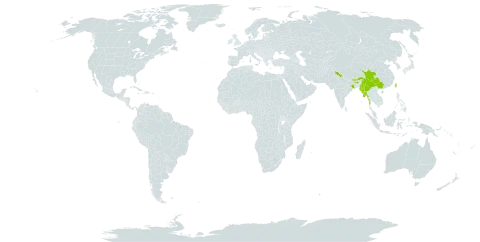Plants evergreen. Rhizome erect, short, densely scaly apically; scales reddish brown, membranous, central part of scales hardened and bright castaneous, ovate-lanceolate, ca. 3 × 1 mm, margins shortly fimbriate or with dense and short cilia, apices acuminate. Fronds 6-32 cm; stipe light stramineous, 0.5-12 cm, 0.5-1 mm in diam., sparsely scaly; scales dimorphic; larger scales similar to rhizome apex scales, reddish brown, membranous; smaller scales lanceolate, sparsely toothed, reddish brown or light brown. Lamina 1-pinnate, green or grayish green when dry, adaxially darker, lanceolate, 3.5-21 × 1-5 cm at middle, not or slightly contracted at base, acuminate or shortly acuminate to obtuse; rachis light stramineous, without proliferous bulbils, sparsely scaly adaxially; scales brown, lanceolate or nearly subulate. Pinnae 7-15 pairs, alternate or nearly opposite, shortly stalked, distant to contiguous, sometimes hardly imbricate, most pinnae attached at right angles with rachis or slightly angled acroscopically, basal 1 or 2 pairs angled basiscopically, sometimes ± angled basiscopically below middle of lamina or most pinnae, rhombic-ovate or nearly oblong, apices acute or obtuse, bases obviously asymmetrical, acroscopic base often with deltoid or nearly deltoid auricles, sometimes only weakly developed, apex of auricles acute, margins of auricles entire or with 1 or 2 shallow obtuse teeth, acroscopic margins of pinnae nearly truncate or slightly raised toward rachis and curved, sparsely toothed, teeth acute, obtuse or weakly repand, rarely with acute and spinulose teeth, basal basiscopic margins cuneate, straight, margins entire, distal basiscopic margins slightly curved upward, toothed same as on acroscopic margins but with fewer teeth; adaxially glabrous, abaxially sparsely covered with lanceolate or subulate, light brown or brown microscales; frond texture thinly leathery; venation pinnate, slightly distinct abaxially, visible adaxially; lateral veins nearly reaching pinna margin, pinnate above midrib from base to apex, trifurcate, dichotomous or simple, simple or dichotomous below midrib. Sori small, medial on each side of midrib of pinna, up to 9 above midrib, less than 4 or sometimes sterile below midrib; indusia present, light brown, entire.
